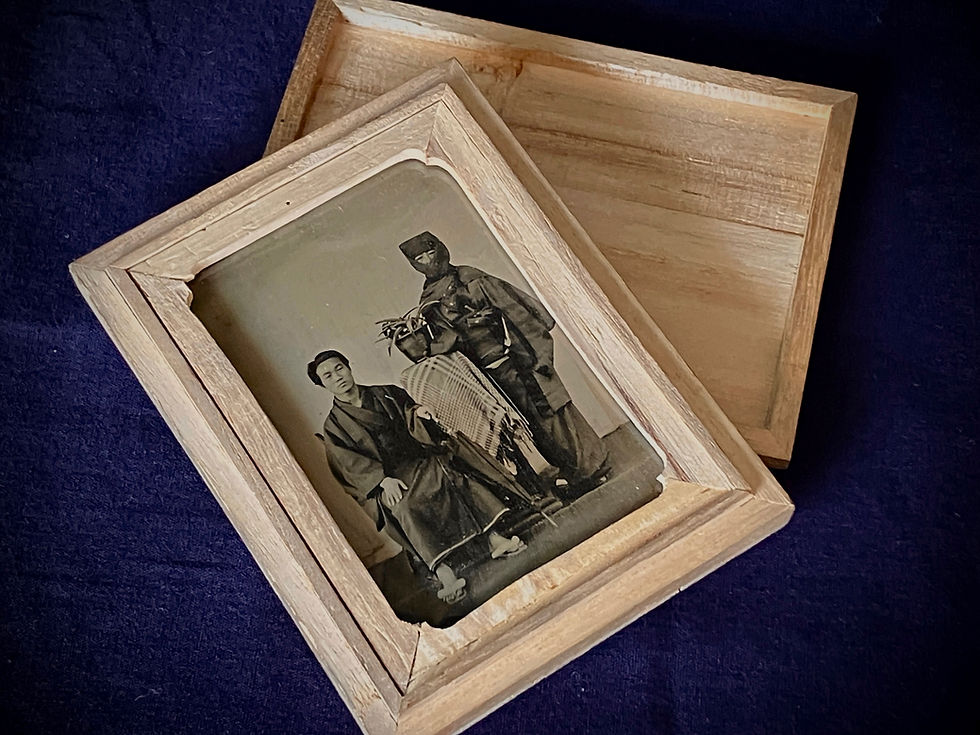Why Wet Plate Photography Feels So Immediate?
- esfahanchaihane
- Sep 12
- 3 min read
Updated: Sep 13
One of the unique appeals of wet plate photography is its visual impact—something you don’t quite encounter in smartphone images or even modern film. There is often a sense of being “looked at,” a striking presence that seems to rise from the portrait itself.
As I reflect on this quality, it seems to stem from three distinct elements. Here, I’d like to share a few thoughts, drawn from my own experience of both photographing and holding the plates in hand.
“Unfamiliar Expression” from the Way Light Behaves

Wet plate photography reacts strongly to light toward the near-ultraviolet range of the visible spectrum. This gives the tones a more subdued look than familiar black-and-white photos, with shadows and eyes appearing deeply defined. Even on a face you know well, the highlights settle, and it can feel like a slightly different presence is emerging.
One of the most captivating aspects is the highlights created by the silver itself. In paper prints, highlights come from the whiteness of the paper, but in wet plates, the silver itself forms the highlights. The tonality feels slightly warm rather than neutral gray, and when light hits the plate, the silver particles catch it and sparkle—a shimmer you can’t experience with paper or a screen. This is a beauty unique to wet plates.
For more detail, check out the “Collodion and Color” section on our website.
“Focused Gaze” from Shallow Depth of Field
When looking at a wet plate portrait, your eyes naturally go straight to the subject’s gaze. Wet plates are extremely low in sensitivity, so photographers need to use bright lenses wide open, which naturally creates the shallow depth of field typical of large-format cameras.

As a result, only the in-focus areas stand out sharply, while the rest gently dissolves. On the actual plate, the in-focus areas appear almost textureless, as if tiny holes are drawing your attention. This kind of focus contrast is very different from modern digital images, where everything is uniformly sharp. The sharp presence of the subject combined with the soft fall-off around it creates a tension that naturally draws the viewer into the subject’s eyes.
“Reality” from Traces and Materiality
For those unfamiliar with wet plates, the uneven textures or small blemishes in the image can seem puzzling at first. It’s impossible to perfectly control a wet plate during shooting, and various forms of “imperfection” often appear. Some examples include:

Oyster shells
Silver halides create distinctive stains on the plate. Among wet plate photographers, this phenomenon is called “oyster shells.” Rather than seeing them as mere stains, they are likened to oyster shells, finding beauty in these accidental traces along the edge.

Crepe lines
collodion wrinkles caused by temperature or drying

Developer streaks
marks left by flowing developer
These marks have chemical causes, but because the photosensitive material is exposed while still wet, environmental factors strongly influence the final image. Naturally, any shortcuts in preparation will show up in the plate.
I always try to minimize flaws, but even then, some traces inevitably remain—and I embrace them. Plates completely free of such traces often feel lacking in wet plate character. Unlike perfectly polished digital images, wet plates retain a certain variability and imperfection. This is the “beauty of imperfection,” carrying the tactile sense of time and the act of making the photograph. Wet plate images also always seem to hold a sense of fluidity, as if the flow of chemistry and light is still present within the plate itself.
I think wet plate photography feels visually striking because these characteristics come together (though, of course, there are other reasons as well).Every time I hold a finished plate up to the light, the person captured in it seems to reach out beyond a mere “photograph.” That intensity, I believe, is the true charm of wet plates.The more I shoot, the more discoveries and insights I gain, deepening my appreciation for the richness of this medium.

About the technique of wet plate photography → What is wet plate photography?
Learn more about wet plates → Wet Plate Journal (blog)
See the actual work → Gallery
Want to try photography or experience it? → Fees/Workshops



